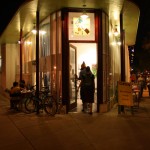It’s a common refrain in the Valley that we have “no history.” This perceived lack of lineage has been used to justify the demolition of countless commercial and residential buildings, even entire neighborhoods. One area that has largely been spared from the wrath of the wrecking ball is Lower Grand Avenue, stretching from Van Buren Street to the I-10 freeway overpass.
Beneath its sometimes gritty façade, Grand Avenue has a long and storied past. Since the mid-1990s, this history has been dusted as many buildings are reverting from industrial uses back to the original small retail and offices that once lined this important connector to Wickenburg, Las Vegas and Los Angeles. An important factor in this renaissance has been the many innovative commercial adaptive use projects in the neighborhood. New owners have preserved parts of the existing vintage structures while making necessary concessions to the realities of modern life. The result is a varied collection of shops, galleries, cafés and living spaces scattered throughout the neighborhood.
Iconic urbanist Jane Jacobs famously said, “New ideas must use old building.” This adage is well exemplified along Lower Grand. The adaptive use of older commercial buildings has been an important factor in nurturing the small business community, particularly the arts. Many small, entrepreneurial businesses are attracted to the funky storefronts, affordable studio spaces and overall neighborhood character. Several of the gallery spaces have passed from artist to artist over the years, maintaining the affordability and fostering a new generation of creative minds.
On September 26, a handful of these adaptive reuse projects will be highlighted during the Grand Avenue Festival. During the morning, tours of six buildings are scheduled as part of the day’s many festivities. Tour stops include the following:
 Tilt Gallery: This house, on the southeast corner of 10th Avenue and Fillmore Street in the Oakland-University Park neighborhood, was built in 1905. It was built of cast concrete blocks, fabricated from molds to resemble quarry stones. It was converted to an art studio and photography gallery in 2005. The current tenants Michelle and Melanie Craven contributed substantial sweat equity towards renovating the building, including stripping and refurbishing the hardwood floors, installing slate flooring in the rear of the gallery and planting desert-friendly plants in the previously all-dirt yard. Today, Tilt Gallery is a contemporary fine art gallery specializing in historical to alternative photographic processes and mixed media projects. The gallery features local, national and international works by emerging and established artist.
Tilt Gallery: This house, on the southeast corner of 10th Avenue and Fillmore Street in the Oakland-University Park neighborhood, was built in 1905. It was built of cast concrete blocks, fabricated from molds to resemble quarry stones. It was converted to an art studio and photography gallery in 2005. The current tenants Michelle and Melanie Craven contributed substantial sweat equity towards renovating the building, including stripping and refurbishing the hardwood floors, installing slate flooring in the rear of the gallery and planting desert-friendly plants in the previously all-dirt yard. Today, Tilt Gallery is a contemporary fine art gallery specializing in historical to alternative photographic processes and mixed media projects. The gallery features local, national and international works by emerging and established artist.
 Jordre Studio: This small commercial building, at 1007 W. Grand Avenue, was originally built as a corner grocery in 1928. A year later, it was operating as both J.B. Johns Grocery and R.L. Mercer Meats. Local artist Kyle Jordre purchased this newly renovated building in 2006, originally constructed of lathe and stucco with a corrugated tin roof, and now uses it as a studio to produce abstract work that includes rich, colorful fields of paint with vibrant, bold textures.
Jordre Studio: This small commercial building, at 1007 W. Grand Avenue, was originally built as a corner grocery in 1928. A year later, it was operating as both J.B. Johns Grocery and R.L. Mercer Meats. Local artist Kyle Jordre purchased this newly renovated building in 2006, originally constructed of lathe and stucco with a corrugated tin roof, and now uses it as a studio to produce abstract work that includes rich, colorful fields of paint with vibrant, bold textures.
Paisley Violin and Paisley Town: This commercial building, one of the few along Grand Avenue with a partial basement, was purchased by Derrick and Gina Suarez in 2004, who relocated their successful Paisley Violin Café there from its former site at Roosevelt and 3rd streets. Standing since 1925, this brick building is the very definition of adaptive use, serving as a grocer, furniture store, tamale vendor, radio repair facility, amusement sales and finally a veterinarian before its current incarnation as a café.
In 2007 the couple relocated six small World War II cottages to the backyard of the premises. They have converted them to colorful small business venues that house a hair salon, ceramic artist, vintage boutique, yoga studio and contemporary clothing boutique, with a florist on the way.
 Motley Design Group: This modest building was constructed in 1957 as a transmission repair shop and was later used as a warehouse and workshop. In 2008, it was rehabilitated as an architecture and engineering studio for Motley Design Group, best known for its work in historic preservation planning and design.
Motley Design Group: This modest building was constructed in 1957 as a transmission repair shop and was later used as a warehouse and workshop. In 2008, it was rehabilitated as an architecture and engineering studio for Motley Design Group, best known for its work in historic preservation planning and design.
 Rehbein Grocery: Located on the corner of McKinley Street and Grand Avenue, the Rehbein Grocery is an excellent example of an early 20th century strip commercial building. It is one of the best remaining two-story brick strip commercial buildings in Phoenix. The building was listed on the National Register of Historic Places in 1985. Today, the space is home to Shop Devious and Lodge Art Studio.
Rehbein Grocery: Located on the corner of McKinley Street and Grand Avenue, the Rehbein Grocery is an excellent example of an early 20th century strip commercial building. It is one of the best remaining two-story brick strip commercial buildings in Phoenix. The building was listed on the National Register of Historic Places in 1985. Today, the space is home to Shop Devious and Lodge Art Studio.
 Bragg’s Pie Factory: This historic 1947 cast-in-place concrete building at 1301 W. Grand Ave was originally built by Alan Bragg and his wife, Elaine, for their expanding family pie business (formerly on Van Buren Street close to the state capitol). The building reflects an international style of modern architecture popular at the time (with few remaining examples left in Phoenix). The main, 4,500-sq.-ft. room in the 15,000-sq.-ft. building is capped by a beautiful steel bow truss roof. It is now home to Sapna Café and several offices and studios, including Modern Cat, Barry Sparkman Studio and Studio 8.
Bragg’s Pie Factory: This historic 1947 cast-in-place concrete building at 1301 W. Grand Ave was originally built by Alan Bragg and his wife, Elaine, for their expanding family pie business (formerly on Van Buren Street close to the state capitol). The building reflects an international style of modern architecture popular at the time (with few remaining examples left in Phoenix). The main, 4,500-sq.-ft. room in the 15,000-sq.-ft. building is capped by a beautiful steel bow truss roof. It is now home to Sapna Café and several offices and studios, including Modern Cat, Barry Sparkman Studio and Studio 8.
Tickets are $10 per person and can be purchased by calling Beatrice Moore at (602) 391.4016 or by visiting the festival website at www.grandavenuefestivalaz.com. Tour times are 8 a.m., 9:30 a.m. and 11 am and leave from Tilt Gallery at 919 W. Fillmore St. Tickets will also be available on the day of the event at Sapna Café, 1301 W. Grand Avenue. Proceeds from ticket sales for the guided walking tours will go to the Grand Avenue Merchants’ Association.








WOW! You never cease to amaze with your insights and research. Thank you Professor Yuri for another fine lesson.
Funny thing about the Rehbein Grocery building, it hasn’t looked like that photo in over 2 years, a photographer was taking photos of Grand Avenue (specially for this event) and he came up with that photo from 2007 lol! The green part of the buidling is now purple. We have open up the entire space for a resale boutique, beauty supplies shop and an internet cafe. The ceiling is adorned with crystals, the walls laden with buttrflies and the racks are packed with recycled wears, refurbished fashions and adaptive re-use items, of which most are sold for way below $15. We are the monthly host to Devious Clothes Swap, which is a free clothes swap open to all, taking place every 3rd saturday from 12-3pm. For more information about ShopDevious.com visit us online. Check out the fashion show on route 60 during the Grand Avenue Festival titled “Fashion in Motion part II”
[…] Bit a lot more info about the buidling’s hstory: This historic 1947 solid-in-put concrete creating at 1301 W. Grand Ave was initially built by Alan Bragg and his wife, Elaine, for their expanding household pie business enterprise (formerly on Van Buren Avenue near to the state capitol). The creating demonstrates an global type of present day architecture well-known at the time (with couple remaining illustrations still left in Phoenix). The major, 4,500-sq.-ft. room in the 15,000-sq.-ft. creating is capped by a stunning steel bow truss roof. […]